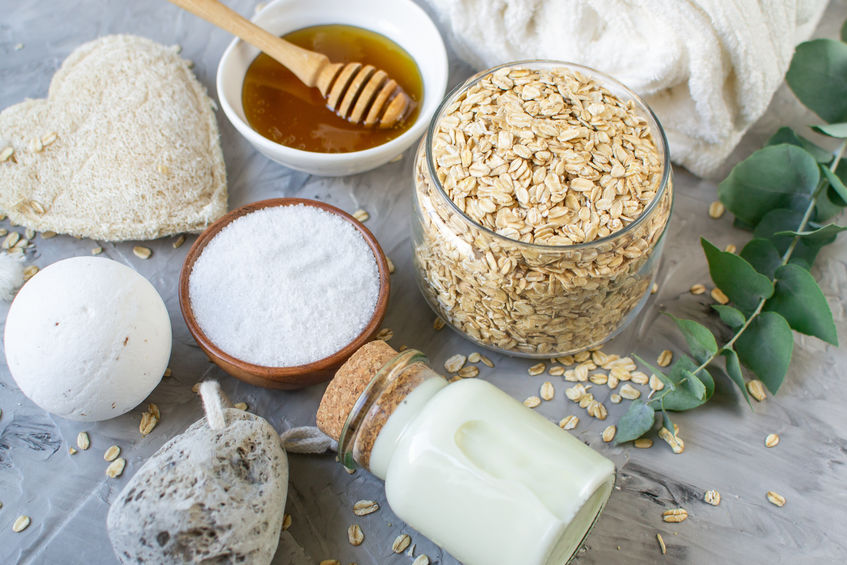One in five people will experience a hives outbreak in their lives. Hives, urticaria, or ‘nettle rash’, (urtica is the Latin term for ‘nettle’) is so prevalent because many factors – dietary, psychological, environmental and chemical – can set off this itchy skin condition.
As there are multiple triggers, it is typically very difficult to establish its cause. Heat or cold, food allergies/intolerance, stress, insect stings or bites, environmental conditions, chemical sources (eg washing detergents), artificial fabrics: As there are so many possible factors, keeping a diary is key to discovering what has caused this inflammatory skin reaction. People with asthma or hay fever also tend to be at more risk of developing hives.
What does hives look like?
Hives has a rash formation of a paler bump (welt or weal), surrounded by a red ring, or halo. Each halo lasts up to 24 hours, but until the rash outbreak clears up, they will reappear on other parts of the body. The duration of your hives outbreak determines whether it is acute, or chronic:
- Acute – lasting up to six weeks
- Chronic – a rarer condition, lasting in excess of six weeks. Chronic hives can last for months or years, coming and going, and it can be hard to establish the source of the infection. Fewer than 5% of hives are chronic.
A careful record of everything you do – where, when and in what circumstances – is the best way to determine all potential triggers of your hives outbreak.
Different types of hives
There are various categories of hives. Angiodema is an associated condition, with swellings beneath the skin, typically around the eyes and lips, though it can affect the hands, feet and genitals. Painful hives lasting more than 24 hours, or that leave a bruise as they heal are likely to be urticarial vasculitis. A type of hives that erupts after stroking the skin, which looks ‘stripy’ or linear is caused by dermatographic urticaria. Though in the vast majority of cases hives is uncomfortable and unsightly, it is generally not a severe health condition. You are advised to seek a diagnosis from a medical practitioner – a dermatologist, allergist or immunologist – in cases of chronic hives.
Self-help and hives
Keeping a diary, feeling that you are taking part and being proactive in discovering what caused your rash, is one way to help yourself when you get hives. There are also ways to cool or calm down your skin:
- Avoid getting overheated.
- Wear loose-fitting clothes made from natural fibres like cotton or linen
- Apply a cooling salve like Aloe Vera gel, Witch Hazel or Calamine lotion
Home treatments effective in taking the heat out of hives:
- Take a warm oatmeal bath: Put oatmeal into cheesecloth or a stocking, tie it up with a rubber band and place it beneath the running tap. It will infuse the water with calming oatmeal
- Add half a cup of baking soda to a warm bath
- Address stress with healing therapies like yoga or massage
- Keep a diary of likely allergens or trigger factors

Keeping a record of all possible causes of hives
Acute hives can spring up then die down within days – often the cause is more clear if you have done something different, been somewhere unfamiliar to you, or eaten something unusual.
However, the cause of chronic hives can be much harder to crack. Keeping a diary of everything you eat and do – have you used different washing detergent? Are you wearing different fabrics? Have you changed your perfume? What did you eat recently? – is key to you helping yourself towards clear skin and good health.
A medically- approved and effective phone app like AlliApp, which easily helps you record your symptoms and the source of all possible allergens, on a day-to-day basis, can really help take the sting out of hives.
When to consult urgently with medical professionals
If the rash covers a large part of your body, if you have difficulty breathing, or if you have a fever, then you should seek urgent medical help. In rare cases, angiodema can affect the tongue, throat or lungs, causing breathing difficulties. This can be life-threatening. In very rare cases, hives or angiodema can lead to anaphylaxis, where the body overreacts to allergens or outside ‘threats’. Symptoms include an itchy rash, throat or tongue swelling, shortness of breath, vomiting, light-headedness, and low blood pressure. Any suspicion of onset of anaphylaxis requires urgent medical attention.

Helping yourself
In the vast majority of cases of hives, the condition is uncomfortable, though not serious or life-threatening. It is irritating and unsightly and can adversely affect your sleeping habits and self-esteem. The surest way to find its cause and prevent it from reoccurring is by keeping a daily record of your lifestyle, diet and habits.
https://www.nhsinform.scot/illnesses-and-conditions/skin-hair-and-nails/urticaria-hives
https://en.wikipedia.org/wiki/Hives
https://en.wikipedia.org/wiki/Angioedema
https://en.wikipedia.org/wiki/Urticarial_vasculitis
https://en.wikipedia.org/wiki/Dermatographic_urticaria
https://theallergygroup.com/Blog/ArticleID/2121/Top-self-care-tips-for-getting-rid-of-Hives-Find-out




